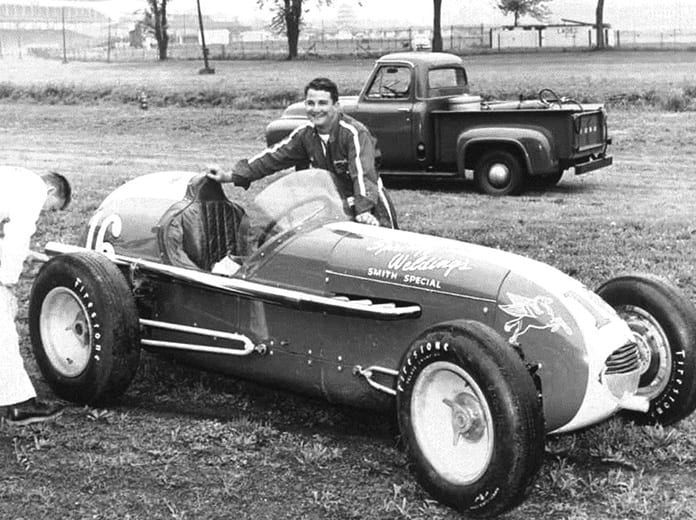“Boy, there was a guy who had about 14 different personalities,” Johnny Boyd laughed as he described his friend Jimmy Reece to writer Terry Reed. “He’d get on a health-kick and become the epitome of the Pope’s altar boy. Quit everything. The next time I’d see him, he’d be so tipped-over he didn’t even know who I was.”
Reece, also known as “Go-Go” because of his effusive, over-the-top, excitable personality, was a trendsetter among his contemporaries. The first to pick up on new clothing styles, hairstyles or the latest technology.
Home movie equipment fascinated him and, in fact, it was Reece who filmed Bob Sweikert’s fatal 1956 crash at Salem (Ind.) Speedway.
Reece also possessed a rare talent in a race car. Among other accomplishments, he was a six-time Indianapolis 500 starter, finishing in the top 10 three times.
Born in Oklahoma City, Okla., on Nov. 17, 1929, Reece’s father raced for a time, so he grew up exposed to the sport. Drivers were his heroes. He never wanted to do anything but drive a race car, and Reece got his start driving a midget in Albuquerque, N.M., during 1946. He lied about his age to race, finished third in the consi and earned $3.80.
In 1947, the 17-year-old Reece, with permission from his father, was a regular midget competitor at Oklahoma City’s Taft Stadium. His success saw him move quickly from stock engine cars into the Offy-powered hybrid machines.
By 1950, he’d attracted the attention of fellow Oklahoman, car owner and wealthy industrialist Jack Zink. Zink not only put Reece in his potent midget but also purchased a stock car for the rising talent.
Reece responded by winning the Texas State Midget Championship and the Taft Stadium Stock Car championship in 1951. With nothing more than midget and stock car experience to his credit, Zink thought Reece was ready for Indianapolis and entered him in the 1952 Indy 500.
The team struggled with getting the car up to speed. With the pressure on, the kid put the ebony No. 37 Kurtis 4000 in the show on the last qualifying day and finished seventh.
After missing the 1953 500 in Bessie Paoli’s car, Reece raced a half-dozen different cars on the Championship Trail. In pursuit of better opportunities, he spent the winter of 1953-’54 in California rooming with Don Freeland and Eddie Sachs while working for Emmett Malloy’s construction company.
Malloy gave him a shot in his beautiful Wally Pankratz-built championship car. Reece performed well with Malloy for two years. Then, typical of an era when driver assignments were in a constant state of flux, he switched teams.
Stellar qualifying runs at Indianapolis in 1956 and ’57, ninth and sixth quick, caught Zink’s attention and Zink hired him for the 1958 500.
Zink had won the 1955 and ’56 500s with A.J. Watson building the cars and turning the wrenches. Zink’s car was a quality ride for a driver headed to the top. Reece responded by grabbing the third spot in the front row, next to his teammate, Ed Elisian.
Ranked as a favorite for the win, Reece became a causality of the first-lap fiasco involving Elisian and Dick Rathmann. The hard-charging duo spun in front of him. He stomped the brakes and Bob Veith hit him from behind, spinning him into Pat O’Connor’s path. O’Connor flipped to his death.
Reece finished the 500 miles with an on-track time 35 seconds quicker than winner Jimmy Bryan. However, a long stop for repairs after the crash relegated him to sixth place.
George Bignotti snatched Reece away from Zink for his Bowes Seal Fast team. “It looked to me like he was going to be a hell of winner,” Bignotti explained.
In their second race together, Reece put the No. 14 roadster on the pole for the Sept. 28 race at Trenton (N.J.) Speedway. As Reece and Johnny Thomson stormed to the white flag, Reece dove under Thomson going into the first turn.
At that point, what happened is uncertain.
Freeland insisted Reece’s throttle stuck. Regardless, the car never turned. It pounded the concrete with a tremendous impact and flew through the air for 150 feet. Upon impact, the car broke in half and flung Reece another 50 feet. He was dead when help arrived.
